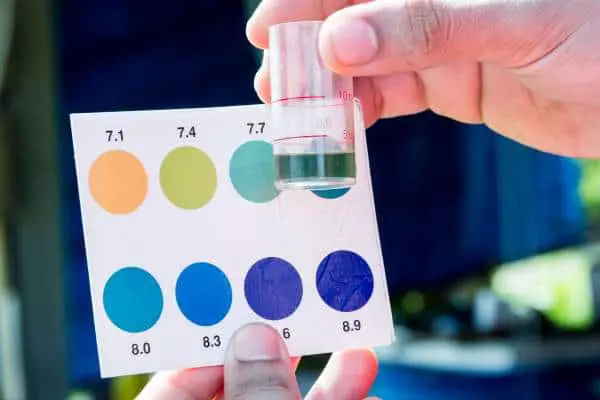When hydroponic growers first begin running their systems, there is one aspect that is so very often overlooked. This is the importance of the water pH level and nutrient solution. If this isn’t around the ideal levels, it can have a dramatic impact on your plants. The most significant thing with a solution pH is it can go up as well as down rather than only in one direction.
If this wasn’t enough, some plants require different levels, so setting the pH to one level can cause harm to some plants if they’re fed from the same reservoir.
Here, we will take a look at everything you need to know about the pH of water, how you can adequately test it, track it, and control it for the benefit of your plants.
Understanding a Hydroponics Systems pH Levels
An Introduction to pH
What is it, and why is it so crucial in hydroponics? The meaning for the term pH means Potential Hydrogen, and it is one of the most essential parts leading to healthy plant growth.
All types of water have different pH levels. Tap water to drinking water and water in your system will all vary. When we measure this, there is a pH scale that reads from 0 – 14, with zero being the most acidic (i.e. acidic water) while at the other end of the range, 14 is the most alkaline (or alkaline water).
Neutral levels are found at number 7, and this like our body is the region in which plants thrive best. With this being said, there are a few plants that prefer a pH level slightly outside the range we consider neutral.
When we look at what this means for our systems, the ideal or standard pH for plants to thrive is under a neutral level, roughly around 5.5 and 6.5. But, there are a few plants that like the other side of the scale and grow best in the region of 8.
When the pH level is correct, it allows plants to absorb all of the essential micro, and macronutrients they need through their root system. Additionally, it is in this ideal range when there are higher uptake levels of the all-important NPK (Nitrogen, Phosphorus, and Potassium) that maximizes plants growing ability.
Understanding the pH Levels of the Plants You are Growing
Plants that are grown in the soil, grow equally well in soils that have varying pH levels and will range from around 6 (slightly acidic) to 7 (neutral). In a hydroponic system in most cases, plants need pH levels that are a little under the recommended for soil.
Here is a list of ideal hydroponic pH levels for a range of plants:
| Plant | Ideal pH Scale |
| Asparagus | 6.0- 8.0 |
| Basil | 5.5-6.5 |
| Broad Bean | 6.0-6.5 |
| Broccoli | 6.0-6.8 |
| Brussel Sprouts | 6.5 |
| Cabbage | 6.5-7.0 |
| Carrots | 6.3 |
| Cauliflower | 6.5-7.0 |
| Celery | 6.5 |
| Chili peppers | 5.5-6.5 |
| Chives | 6.0-6.5 |
| Cucumber | 5.5 |
| Eggplant | 6.0 |
| Leek | 6.5-7.0 |
| Lettuce | 6.0-7.0 |
| Parsley | 5.5-6.0 |
| Pea | 6.0-7.5 |
| Spinach | 6.0-7.5 |
| Strawberries | 6.0 |
| Thyme | 5.5-7.0 |
| Tomato | 5.5-7.5 |
| Zucchini | 6.0 |
This list is by no means extensive and these are indicative of the levels required.
Testing and Measuring the pH of your Hydroponic Nutrient Solution
If you are a new grower, you will need a daily check of your solution to check the pH levels. After a while, you will come to understand your system and how all of the nutrient concentrations and water types you are using will affect the levels.
Before heading off with testing methods, it is essential to know the effect that different water types can have on a hydroponic system, and why many growers decide to use reverse osmosis water rather than tap water.
EC levels are the amount of conductivity the nutrient solution can have, or in simple terms, the amount of electricity that can pass through the solution. EC is dictated by the salt levels that are in a solution. EC though doesn’t tell you what salts are in your mix, hence the reason for growers using reverse osmosis water. They want a clean slate on where to begin so there is no guessing.
Once they have this water, they can take their nutrient bottles, and will then know precisely what will be in their solution. A point to note here is, never purchase nutrients that don’t come with a guaranteed analysis, or are from a highly reputable company. All too often cheap nutrients can cause more harm than good to your plants.
By using good water, the levels of pH will require less adjusting, and doing so will give less shock to your plants. Now, you can either decide to use reverse osmosis water from the beginning, or you can adjust the EC levels and then focus on your pH levels.
See also: What are the Best pH Meters in 2022?
Ways of Measuring pH Levels in Hydroponic Systems
There are three ways in which you can measure the pH levels in your system. Here is an overview of the methods available.
Litmus pH Test Strips
The simplest way is by means of litmus paper strips. Litmus paper contains a dye that is sensitive to the liquid it is dipped into.
In this case, it would be a sample of your nutrient solution. Once you have this sample and you have dipped your strip, you wait until the color changes, and this is then compared to a chart that shows the pH level.
Although this method is the cheapest, it isn’t the most reliable. Some of the colors for the different levels are very close, and comparing a small squab can leave you guessing which one it is. For some plants, this approximate measure of the difference in pH might not be significant, but for others, it can leave your plant battling for survival!
For a quick means of testing, they are handy to keep close to your growing area, but shouldn’t be relied on.
Liquid pH Testing Kits for Hydroponics
This liquid pH testing kits cost slightly more than their litmus counterparts, but with this price increase, there is more accuracy. This form of testing water pH is commonly found in people who have swimming pools, so the process has been well tested over the years.
The way you perform this test is to take a sample of your nutrient mix, and then place a few drops of sensitive dye into the container. After a short while, the color changes and is then compared to a chart representing the pH levels similar to the first method.
Like the first option, there are drawbacks and the most significant being the color shades can be hard to detect and interpret. Both these tests should be carried out in good lighting conditions so as not to affect the reading of the colors.
Testing Hydroponic pH Levels with an Electric Meter
The final option is the most expensive, but it does give exact results without growers misinterpreting the reading of a color chart. These electronic pH testing meters vary in design, size, and price. One of the most common varieties is a digital pH pen. Once this is placed in the sample of the nutrient mix, it will give a digital reading of the exact level.
Although these are precise in their readings, this can vary over time, and they do need calibrating on a regular basis. In some cases, this can be weekly. This might seem to be a little overkill for some growers, but when it can be the difference between healthy plants, and ones that are suffering from a nutrient lockout, it can be a chore worth doing.
What you Need for Calibrating a pH Pen
There are two forms of calibration for these pens: digital and manual. We will run through the calibration of both, and first off is the equipment you will need:
- Your pH Pen
- Calibration solutions: One at pH 4, pH 7, and pH 10
- Distilled water
- Small measuring cups
- Gloves
- A small screwdriver will be required if you have a manually calibrated pH Pen
Digital pH Pen Calibration
Many of the pens use similar methods for calibration, so these steps will more than likely suffice for whatever digital pen you have.
- While wearing gloves, pour a small amount of the calibration liquid into separate measuring cups (solution must be at room temperature). Now you will have one for 4, 7, and the third for pH 10. This solution should be as fresh as possible, so when purchasing, refrain from thinking a large bottle is leading to a cost-saving.
- Before commencing, ensure the pens probe is clean, (Refer to cleaning pH pen section).
- Check the pen’s instructions for performing the test on the pH 4 solution. Most pens have a guide marker where you should submerge the pen too, when it is at this level, gently swirl it in the solution.
- Rinse the probe with distilled water, and then test on the two higher pH solutions.
- Not all pens require a 3-step test, but the more calibration points, the more accurate your pen will be.
Calibrating a Manual pH Pen
Although it might sound harder to calibrate your pH device by using a screwdriver, the process is straightforward. The actual testing phase is exactly the same, and all you do with the screwdriver is adjust the dial to match up with the pH.
Again, the more often you perform this calibration, the more accurate the results you will obtain. For anyone with an average-sized garden, a period of between 2 to 3 feeds should be okay for pen calibration.
How to clean a pH Pen
Before use and in between calibration tests, the probe on the device needs to be clean. For 15 minutes before you conduct your solution testing, the electrode needs to be soaked in a buffering solution. If you have none of this solution, refrain from using any other water, because even distilled can erode the glass membrane.
If your pen’s electrode has been allowed to dry, you must soak it in the storage solution or a cup of pH 7 buffer solution before performing your testing. If the pen has been in storage, gently shake it up and down to disperse any bubbles which may have formed.
Keeping the electrode clean is one way not to affect the operation of the device. You should never wipe the electrode because this can affect any static charge in the device. Gently blot the device and bulb with lint-free paper. You should also be sure to never touch the bulb with your fingers, if you don’t damage the device probe, you can leave behind a residue that will stop the device from giving accurate results.
Some devices need storing in a recommended storage solution. These can be purchased, and when the device is stored and cleaned as instructed, they will deliver fast and accurate results.
pH Levels of Different Hydroponic Systems
Now we have seen the equipment you can use to test your solution, and how you need to calibrate your device. We will take a look at how different systems can have different pH levels. NFT is straightforward because the solution is in direct contact with the roots.
If you have a media-based system, the readings can be a little more intense. Two readings need to be taken, one from your reservoir, and the second from the runoff solution (the leachate). If you have large plants, then there will be a difference in this before and after scenario. When you come to adjust your solution, you need to base the adjustments to your reservoir based on the pH of the leachate solution. This adjustment is required because it will be the level of PH your plants will be experiencing rather than the pH which is in the reservoir.
Adjusting Hydroponic pH Levels
There are a few reasons why your pH levels will rise or fall, and luckily, it can be quite easy to fix them. One of the easiest ways to avoid any spikes or drops in levels is to make sure your nutrient solutions contain pH buffers.
Many of the nutrient suppliers will also offer solutions that can raise or lower pH levels as required. One of the most well-used is pH UP and pH Down from General Hydroponics. When using these, it is crucial to follow the recommended doses, and in relation to how close to the desired levels your solution is when you test.
If your pH levels swing too far in either direction on the pH scale, plants can suffer from the nutrient lockout, so it is vital to regularly test these levels until you have a better understanding. When it comes to making these adjustments, there are only a few steps involved:
- Depending on your reading – add 1-2 ml of pH Up or pH Down per gallon of water.
- Stir your solution and wait for 30-minutes before testing your solution a second time
- Repeat as necessary until you reach the desired range for your plants
Your pH levels will change when you add nutrients, so you should always test once these have been added to a fresh tank. Apart from that, it is advisable to check around the same time each day. There are a couple of natural methods to adjust pH if you are out of any pH Up or pH Down. These are short-term fixes and should only be used if it is absolutely necessary.
Citric acid or white vinegar can be used to lower pH, while baking soda can be used to raise your pH levels.
Maintaining pH Levels in Hydroponic Systems
To finish off, here is a quick recap of how you can maintain your pH levels:
- Check levels on a daily basis until you understand your system. After this, as you gain experience, once or twice per week might be enough.
- Use the best testing kit you can. Litmus strips are best used for quick periodic testing.
- If you see your pH levels are between 5.8 – 6.5, don’t be tempted to adjust anything. This is ideal for the majority of plants.
- If your solution is too high then lower it with pH Down (phosphoric acid).
- If the level is too low, then raise it with pH UP (potassium hydroxide).
- Don’t rush for a quick fix to your pH levels, too much too quickly will shock your plants.
- Keep records of how much solution you add to your tank.
Depending on where you live and are using tap water, you might not require too much adjustment, but for hard water areas, the change can be more significant.
Overdosing with either of these pH adjusters or nutrients can be harmful to your plants. Additionally, if your solution levels drop in your tank, then the pH levels will be changing at the same time. Much can be said if you are topping your tank with water, again your levels will vary.
Understanding pH levels is one of the best skills any hydroponic grower should take the time to learn.





